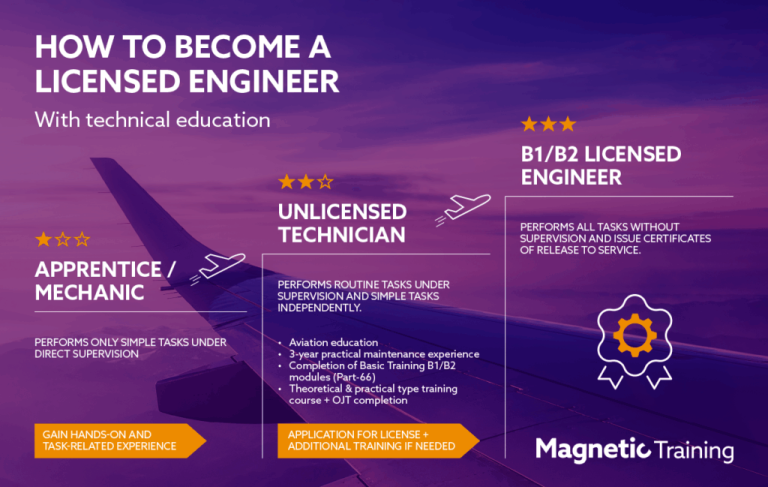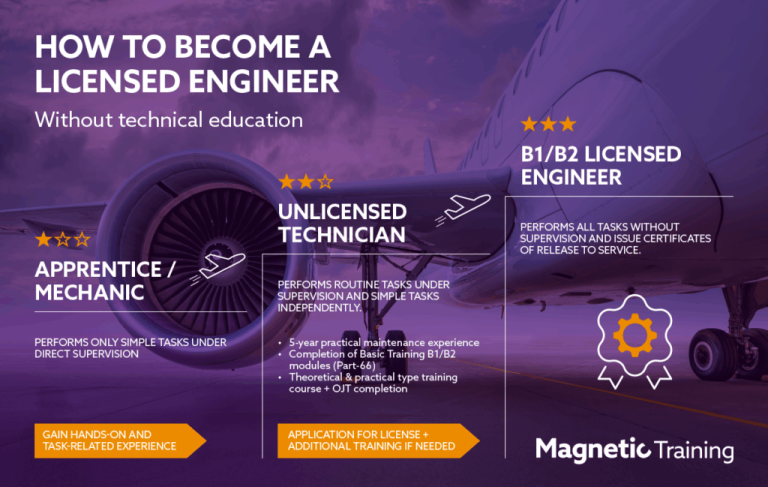It’s no secret that the global aviation industry is expanding, but behind every aircraft that takes off safely, there’s a lesser-known story: the critical need for licensed maintenance engineers.
With global aircraft fleets projected to grow from 29,000 to over 38,000 in the next decade, and manufacturing delays pushing airlines to extend the life of older jets, the maintenance sector is facing mounting pressure. And yet, fewer young people are entering the field.
“We’re looking at a shortfall of roughly half a million engineers over the next ten years,” says Ene Krinpus, Managing Director of Engineering & Training Services at Magnetic Talents.
“The industry knows this. Airlines know this. And so do we. That’s why training isn’t just a service – it’s a responsibility.”
What is aviation technical training, and why does it matter?
Put simply, aviation technical training prepares individuals to inspect, maintain, and certify aircraft for flight. But in a high-stakes industry like aviation, training goes far beyond basics. It’s a blend of theory, regulations, precision, and thousands of hours of hands-on practice.
Every nut, wire, and inspection sign-off must meet international safety standards – most commonly those set by EASA (European Union Aviation Safety Agency) or based on EASA standards
Training includes:
- Basic training / exams
- Aircraft Type training courses (e.g., A320, B737) together with the on-the job training experience.
- GenFam (General Familiarization) courses
- Specialized instruction like boroblend or structural repair
- Mandatory training, such as EWIS, FTS, and Safety training (inc Human Factors)
“It’s not just technical knowledge we’re building,” Ene explains. “It’s trust. The kind of trust that lets a passenger board a plane without second thoughts.”

Two paths to licensure: from classroom to cockpit access
Whether you’re coming straight out of school or pivoting mid-career, there are two main ways to become a licensed aviation maintenance engineer: the academic path and the apprenticeship path.
The formal education route
This traditional route involves enrolling in a vocational or higher education program focused on aviation maintenance. In Estonia, these programs are typically 3 – 4 years long and include both:
- Theoretical modules (including physics, electronics, materials science, regulations)
- Hands-on practical tasks in simulated or executed in real MRO environments
Many institutions also integrate Part-66 module training, giving students a head start toward their “empty licence” – the base license required before pursuing type ratings and OJT.
Once the classroom portion is completed, graduates must work within an approved maintenance organization for an additional 3 – 4 years to fulfill their hands-on requirements.
“It’s a long process – 8 to 9 years in total; but for someone who values academic structure and progression, it’s a solid foundation,” Ene adds.
Afterward, the individual must complete a type training course on a specific aircraft (such as the Boeing 737 or Airbus A320) and finish an on-the-job training (OJT) program.
Only then can they operate as a fully licensed engineer.
The apprenticeship route – learning by doing
This path skips the formal academic degree and instead focuses on on-the-job learning, ideal for career changers or those who prefer practical experience.
Through the internal Magnetic Academy training program, trainees can enter the field without any prior aviation background.
The key requirements? Good English language skills, good hands-on skills, and a passion for technical work.
The journey starts with Zero2Hero – a structured six-month program that combines:
- 350 hours of classroom theory on subjects such as aircraft systems, electronics, mathematics, and materials science
- Rotating maintenance work (2 – 3 weeks) between classes
“It’s the real deal from day one,” said Ene. “You’re not just learning about aircraft – you’re touching them. Turning bolts. Seeing what can go wrong and how to fix it.”
After Zero2Hero, apprentices continue working full-time while logging the 5 years of experience required for licensure. They then proceed to the Part-66 Basic Module Courses, delivered and financed by Magnetic.
Once modules are passed and experience validated, they can apply for the empty licence and, like in the formal path, complete their type rating and OJT.
“The flexibility of this route is a huge draw. You’re working, earning, and learning all at once,” she adds. “It’s not easy, but it's real-world training.”
Training that reflects reality
Magnetic Training offers an extensive and evolving suite of courses, delivered across multiple international hubs.
Here’s a look at what’s on offer:
Aircraft type training
- Narrow-body: Airbus A320, Boeing 737, Embraer 190, and more
- Wide-body: Airbus 330, Boeing 777, Boeing 787, etc.
- Includes both theoretical and practical elements
GenFam / specialized trainings
- General Familiarization courses on various aircraft and engines
- Ideal for support personnel or entry-level technicians
- Borescope Inspection (BSI) training courses
- Boroblend repair
- Sheet metal techniques
- EWIS (Electrical Wiring Interconnection System)
- Safety training (incl. Human Factors)
And more
“We don’t just teach how things work – we teach why they matter,” says one of Magnetic’s instructors.
“One mistake on an aircraft can cost lives. That perspective changes how you train, and how seriously you take the process.”
Success stories: from apprentice to instructor, and beyond
Magnetic’s alumni don’t just earn licenses – they build careers.
One standout is Risto Mäeots, Magnetic Group’s current CEO, who began his journey as an intern on the shop floor.
“He came in during his university studies and just… never left,” Ene laughs.
“Now he’s leading the whole Group.”
Other inspiring stories include:
- A training instructor who began with no aviation education, studied independently, and is now a licensed engineer teaching the next generation.
- A former IT sector professional who followed his passion, joined Magnetic Academy 5 years ago and today is preparing to start his OJT program to be a licenced engineer in a a year or so.
“These aren’t exceptions – they’re proof. Proof that with the right environment and guidance, people can achieve incredible things, even in a field as demanding as aviation maintenance.”

What lies ahead: training for the future
The aviation training landscape is changing – fast.
“We're seeing a shift from traditional classroom models to AI-enhanced, immersive, and personalized learning environments,” says Ene.
“But we must not lose sight of the hands-on component. Simulators are great – but they don’t replace turning a wrench on a real engine.”
However, not all changes are technological. One of the biggest current hurdles is regulatory; specifically, the availability and structure of OJT programs.
The process for logging experience post-type training remains complex and inconsistent across different regions.
“The recent developments around the OJT program is slowing down the flow of qualified engineers,” stresses Ene. “This is something that needs to be addressed industry-wide – through clearer guidance, standardization, and collaboration.”
Magnetic Training is also planning to expand into non-technical training for support functions like logistics, planning, and customer service; recognizing that maintaining aircraft involves far more than just tools and overalls.
Final thoughts: why training is more than a requirement
Technical training in aviation isn’t just about qualification – it’s about confidence, credibility, and contribution. Aircraft engineers are entrusted with safety on a scale few other professions encounter.
“You don’t just fix aircraft,” Ene concludes. “You make flight possible. You get families home. You keep business moving. That’s what makes this work so meaningful.”
Whether you’re starting fresh, looking to switch careers, or already working in aviation and want to advance – there is a path. And Magnetic Training is here to guide you through it, every step of the way.